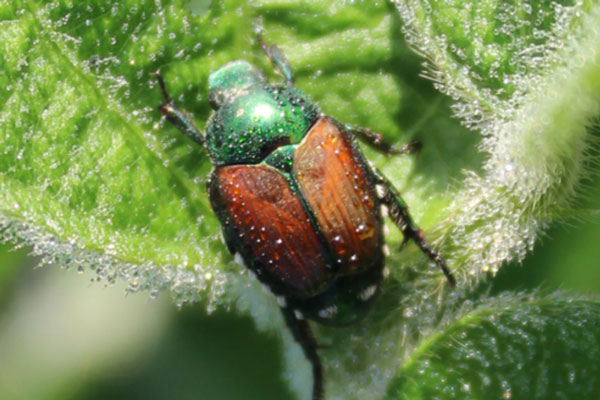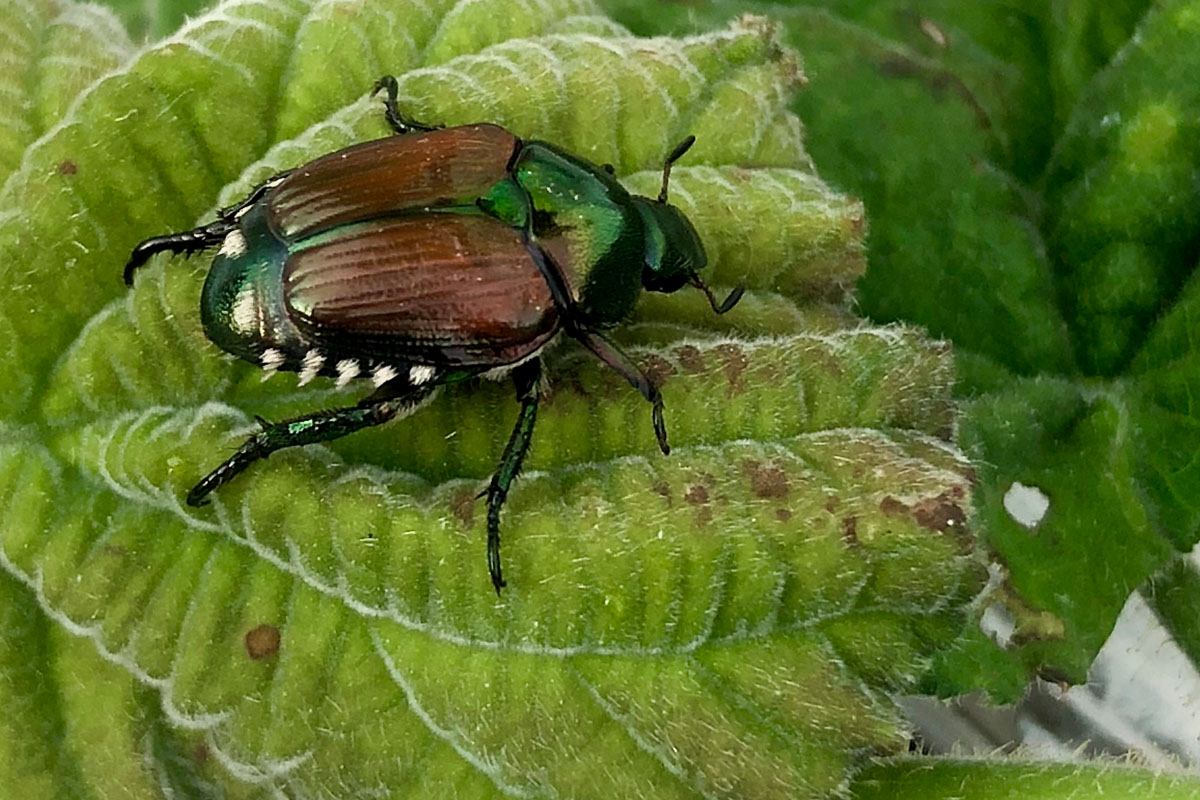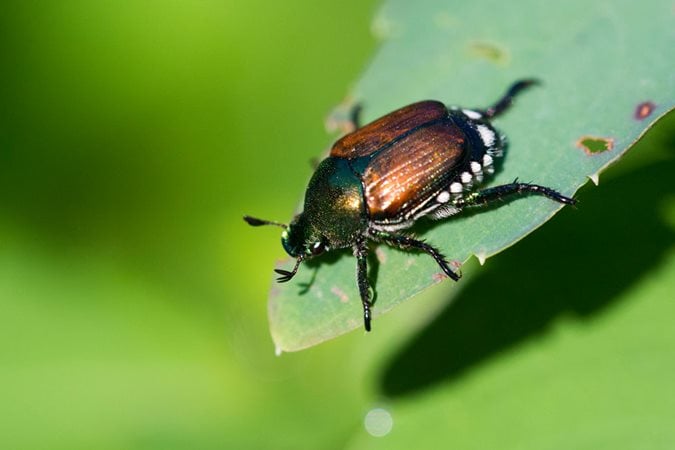japanese beetle life cycle in missouri
Japanese beetle are distinguished from native beetles by the presence of five pairs of white tufts on their abdominal sides and two additional tufts on the abdomen tip. As soon as cucurbit plants are.

Japanese Beetle Habitat Facts How To Get Rid Of Japanese Beetles Safer Brand
Most of the beetles life is spent underground only emerging in the adult phase we all know and loathe.

. Japanese beetle have one generation per year Figure 2. Injury to Soybean Fields Japanese beetles feed on more than 300 plants including field crops and ornamental plants. A few weeks after hatching from the eggs small larvae begin to feed on grass roots then transform into pupae where they rest before emerging as adults.
Life Cycle of the Japanese Beetle. How to Recognize the Japanese Beetles Life Stages. Egg larvae and pupa.
A Japanese beetles life cycle comprises the egg grub pupa and adult stage. The adult beetles eat the leaves and flowers of over 300 plants by eating the tissue between the veins a type of feeding called skeletonizing. When Japanese beetle grubs are sufficiently abundant in turf 100 or more per square yard the grass turns brown and dies owing to the destruction of the root system.
Adult Japanese beetles are about ½ inch long and are shiny metallic green with metallic bronze wings. The beetles range appears to be increasing. These grubs will begin.
Japanese beetles overwinter as a partially grown grub in the soil below the frost line. Japanese beetles complete one life cycle each year. The adult Japanese beetle is a little less than half an inch long and has a shiny metallic-green body with bronze-colored outer wings.
Life Cycle Striped cucumber beetles overwinter as adults. In the early spring they begin to feed again and turn into resting pupae. The males usually are.
Is necessary for the completion of the entire life cycle. This insect can significantly damage landscape plants ornamental plants fruit and vegetable gardens nurseries orchards and agricultural crops. This pest was detected in New Jersey in 1916 having been introduced from Japan.
The grubs resume feeding on grass roots in the spring and then pupate near the soil surface. Adults emerge between May and July depending on their geographic location. Females lay eggs in soil that hatch within seven to 14 days and grubs begin feeding on grass roots.
It is common for this pest to be abundant in one part of a town and not others. Appearance of adult the timing of oviposition and subsequent development have been shown to vary with latitude altitude and also from year to year Fleming 1972. Mature larvae feed on the roots of host plants causing severe damage over time while adults skeletonize leaves in groups as well as any fruit that may have grown.
The grubs live underground for about a year. Adults begin to emerge in May and feed on foliage through September. Then they start to feed on wild cucurbits and plant blossoms.
Shortly after the egg will hatch and give rise to grubs. In the summer around June or July full-grown beetles will lay eggs. Look the life cycle of the Japanese beetle is much like the cycle of many other beetles.
Females lay eggs in soil. The grub stage can further be sub-divided into three instar stages and is the longest of all stages in the life of a Japanese beetle. The Japanese beetle Popillia japonica Newman is one of the most abundant pests in Ohio.
Japanese beetle have one generation per year Figure 2. Severe damage is especially noticeable during dry periods. Thus their life cycle requires a full year to complete.
The adult female will lay eggs in soil or near the base of plants. Adults begin to emerge in May and feed on foliage through September. University extension and state agriculture departments help people control the Japanese beetle.
Life Cycle After mating females burrow a few inches into the soil and lay eggs 4060 during a summer. Grubs cease feeding in October and overwinter 15 cm below the soil surface Figure 3. The Japanese beetle has four stages in its life cycle two of which can be destructive to your lawn and garden.
The life cycle of Japanese beetles consists of three stages. The beetle has six small tufts of white hair along the sides and back of its body under the edges of its wings. The pupae hatch into adults and emerge from the soil in spring.
Adult beetles generally start feeding on leaves growing on the top of the infected plant which is a sign of a Japanese beetle infestation. In mid-Missouri beetles begin to emerge from overwintering in early or mid-May. Adult Japanese beetles also have 6 white tufts of hair along their abdomen.
They remain on the edges of fields or in woods under litter or other plant debris. In most parts of its range the Japanese beetle completes its life-cycle in one year but some populations in cooler climates may complete their development in two years Vittum 1986. Japanese beetle has one generation per year and overwinters as a grub larva in the soil.
After mating females burrow a few inches into the soil and lay eggs 4060 during a. Japanese beetle Popillia japonica is an invasive plant pest that was first introduced to eastern North America from Japan in 1916.

Japanese Beetle Soybean Pest Soybean Research Information Network Srin

Japanese Beetle Japanese Beetles Gardener S Supply

Japanese Beetle Soybean Pest Soybean Research Information Network Srin

Japanese Beetle Pest Monitoring Integrated Pest Managment University Of Missouri

Japanese Beetle Soybean Pest Soybean Research Information Network Srin

Japanese Beetles In Soybeans Service And Supply Cooperative

How To Get Rid Of Japanese Beetles Effectively 2022 Pestkilled

How Do I Control Japanese Beetles Green Seasons Lawn Tree Service

Japanese Beetle Control The Good Earth Garden Center

Japanese Beetle Soybean Pest Soybean Research Information Network Srin

Effective Management Remains Elusive For Beetle That Eats Almost Anything

Japanese Beetle Control The Good Earth Garden Center

How To Get Rid Of Japanese Beetles Garden Design

Goldenrod Soldier Beetle Chauliognathus Pensylvanicus




